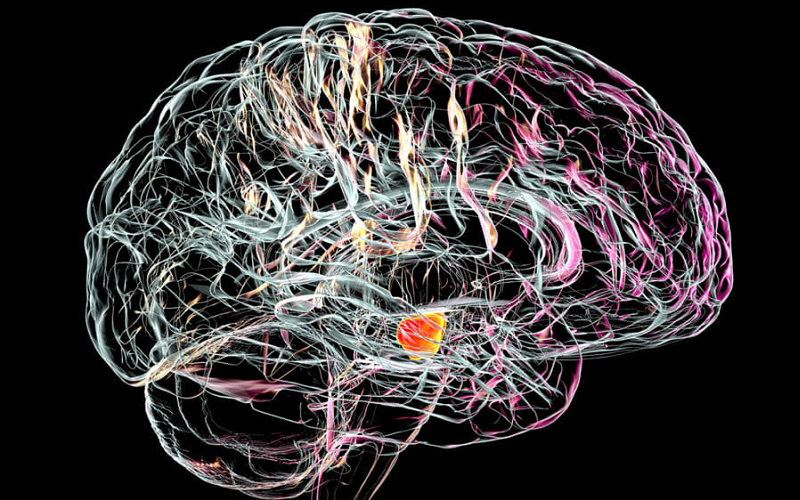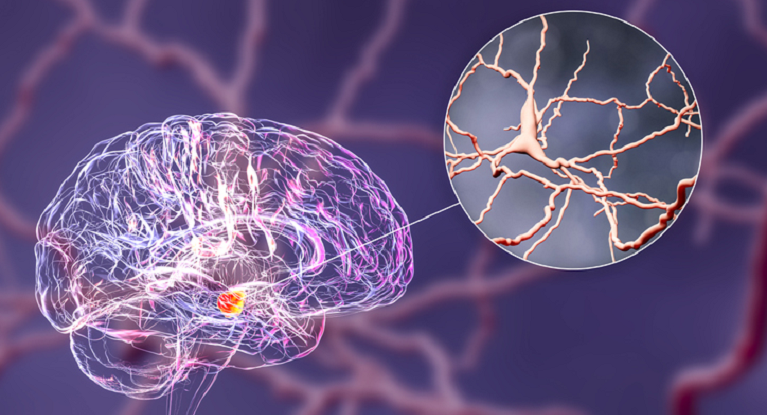
Nestled within the midbrain, this small yet powerful Substantia Nigra area plays a crucial role in controlling movement and is integral to our understanding of various neurological disorders. Here we explore the intricacies of the Substantia Nigra, from its structure and neurochemical makeup to its vital role in the orchestration of motor functions. We also examine how dysfunctions in the Substantia Nigra contribute to movement disorders, most notably Parkinson’s Disease, where its degeneration leads to profound motor impairments.
Contents
The Basics of Substantia Nigra
Before getting into the details of the Substantia Nigra complex functions and implications in health and disease, it’s essential to understand what the Substantia Nigra is and where it’s located.
Definition and Location of the Substantia Nigra
The Substantia Nigra, Latin for “black substance,” is aptly named for its dark coloration, a result of high levels of neuromelanin in dopaminergic neurons. This structure is situated in the midbrain, an area that connects the forebrain and hindbrain, playing a pivotal role in motor control and a host of other functions. As a part of the basal ganglia, the Substantia Nigra is a hub of neural pathways that regulate movements, influencing both voluntary and involuntary actions.
Structural Components of the Substantia Nigra
The Substantia Nigra is not a uniform structure; it comprises distinct parts, each with its unique function and type of neurons.
Pars Compacta
The Pars Compacta, or SNc, is known for its dense aggregation of dopaminergic neurons. These neurons are critical in producing dopamine, a neurotransmitter that is key in movement, motivation, and reward. The SNc’s health and functionality are essential for normal motor control.
Pars Reticulata
In contrast, the Pars Reticulata, or SNr, primarily contains GABAergic neurons. Unlike the SNc, it’s involved in the output pathways of the basal ganglia. The SNr plays a role in relaying inhibitory signals to other parts of the brain, influencing the initiation and modulation of movements.
Neurochemical Profile of the Substantia Nigra
The neurochemical landscape of the Substantia Nigra is rich and complex, underscoring its role in various brain functions.
Dopamine Production
The SNc’s neurons are the primary source of brain dopamine. This neurotransmitter is crucial for motor function, emotional responses, and the reward system. The proper balance of dopamine is vital for coordinated movements and overall well-being [1].
Other Neurotransmitters
Besides dopamine, the Substantia Nigra also interacts with various other neurotransmitters, like GABA, glutamate, and serotonin. This interaction forms a complex network that regulates numerous aspects of both motor and non-motor functions.

Role of Substantia Nigra in Movement Control
Having established the fundamental aspects of the Substantia Nigra, we now turn our attention to its pivotal role in movement control. This area of the brain is not just a static structure but a dynamic orchestrator, influencing and regulating a variety of motor functions. The Substantia Nigra’s involvement in movement is both intricate and vital, working in concert with other brain regions to ensure fluid and coordinated motion.
Interaction of the Substantia Nigrawith Basal Ganglia
The Substantia Nigra’s most significant contribution to movement control is through its interaction with the basal ganglia, a group of nuclei in the brain associated with a variety of functions including motor control, behaviors, and emotions. The Substantia Nigra, particularly its pars compacta section, sends dopaminergic signals to other parts of the basal ganglia.
This interaction is crucial in regulating the balance between movement initiation and inhibition. Dopamine released by the SNc modulates the activity of neurons in the striatum and globus pallidus, which are key areas in the motor circuit. This modulation is essential for smooth and purposeful movements [2].
Influence of the Substantia Nigra on Motor Planning
The Substantia Nigra also plays a key role in motor planning, which involves the preparation and execution of movements. Dopamine acts as a messenger, conveying signals that inform the brain about when and how to initiate movements. This neurotransmitter’s influence extends to motor learning, where the Substantia Nigra contributes to the acquisition of new motor skills and the refinement of existing ones. The feedback it provides helps in adjusting movements, ensuring they are precise and coordinated.
The Substantia Nigra and Regulation of Muscle Activity
In addition to influencing higher-level motor planning, the Substantia Nigra is directly involved in the regulation of muscle activity. The signals it sends and receives help maintain muscle tone and prevent unwanted movements. When the Substantia Nigra functions properly, movements are smooth and controlled; when its function is compromised, as seen in certain neurological disorders, this can lead to tremors, rigidity, and other motor impairments.

Substantia Nigra and Parkinson’s Disease
The significance of the Substantia Nigra becomes particularly evident when examining its role in Parkinson’s Disease (PD), a progressive neurological disorder predominantly characterized by motor symptoms.
The Substantia Nigra and Parkinson’s Disease Connection Explained
Parkinson’s Disease is primarily associated with the degeneration of dopaminergic neurons in the Substantia Nigra, particularly in the pars compacta region. As these neurons deteriorate, dopamine levels in the brain decrease significantly. Since dopamine is a key neurotransmitter for controlling movement, this depletion leads to the motor symptoms commonly seen in PD patients, such as tremors, rigidity, bradykinesia (slowness of movement), and postural instability [3].
Dopamine Depletion Effects
The effects of dopamine depletion are far-reaching. Dopamine not only facilitates smooth and coordinated movements but also plays a role in motivation and reward. Thus, its reduction can lead to both motor and non-motor symptoms, including mood disorders, cognitive changes, and sleep disturbances. The progressive nature of this depletion in PD makes the symptoms worsen over time, increasingly affecting the patients’ quality of life.
Parkinson’s Disease Symptoms and Diagnosis
The diagnosis of Parkinson’s Disease is primarily clinical, based on the presence of its cardinal motor symptoms. However, by the time these symptoms become apparent, a significant number of dopaminergic neurons in the Substantia Nigra may have already been lost. This highlights the need for early detection and intervention strategies.
Current Treatments and Research for Parkinson’s Disease
While there is no cure for Parkinson’s Disease, current treatments primarily focus on managing symptoms. Most therapies aim to increase dopamine levels or mimic its action in the brain. Levodopa, a precursor of dopamine, is commonly used, along with other medications that either enhance dopamine release or inhibit its breakdown. Research is ongoing to develop more effective treatments that not only alleviate symptoms but also slow down or halt the progression of the disease. Gene therapy, stem cell therapy, and deep brain stimulation are among the promising areas of research offering hope for future advancements [4].
Other Disorders Involving Substantia Nigra
While Parkinson’s Disease is the most well-known condition associated with the Substantia Nigra, this critical brain structure is also implicated in several other neurological and psychiatric disorders. Understanding these conditions sheds light on the diverse roles of the Substantia Nigra and underscores the importance of this area in overall brain health.
Dystonia and Substantia Nigra
Dystonia, characterized by involuntary muscle contractions leading to abnormal postures and movements, is another disorder linked to the Substantia Nigra. Although the exact mechanism is not fully understood, research suggests that dysfunction in the dopaminergic system, particularly involving the Substantia Nigra, plays a significant role. This dysfunction may disrupt the delicate balance of neural pathways regulating muscle control, leading to the symptoms observed in dystonia [5].
Schizophrenia and Substantia Nigra
The Substantia Nigra’s role extends beyond movement disorders to psychiatric conditions like schizophrenia. Schizophrenia is associated with altered dopamine activity, and studies have shown changes in the Substantia Nigra of affected individuals. These changes may contribute to the positive symptoms of schizophrenia, such as hallucinations and delusions, by affecting dopamine regulation in the brain.
Substantia Nigra and Addiction and Substance Abuse
The Substantia Nigra is also involved in addiction and substance abuse disorders. The dopamine system, with the Substantia Nigra as a key player, is central to the reward circuit of the brain. Dysfunctions in this system can lead to altered reward processing, contributing to the development and persistence of addictive behaviors. Understanding the role of the Substantia Nigra in this context is crucial for developing effective treatment strategies for addiction.
References
[1] Substantia Nigra (SN): What It Is, Function & Anatomy
[2] Neuroanatomy, Substantia Nigra
[3] Substantia Nigra
[4] Know Your Brain: Substantia Nigra
[5] Neurotransmitter Receptors in the Substantia Nigra

